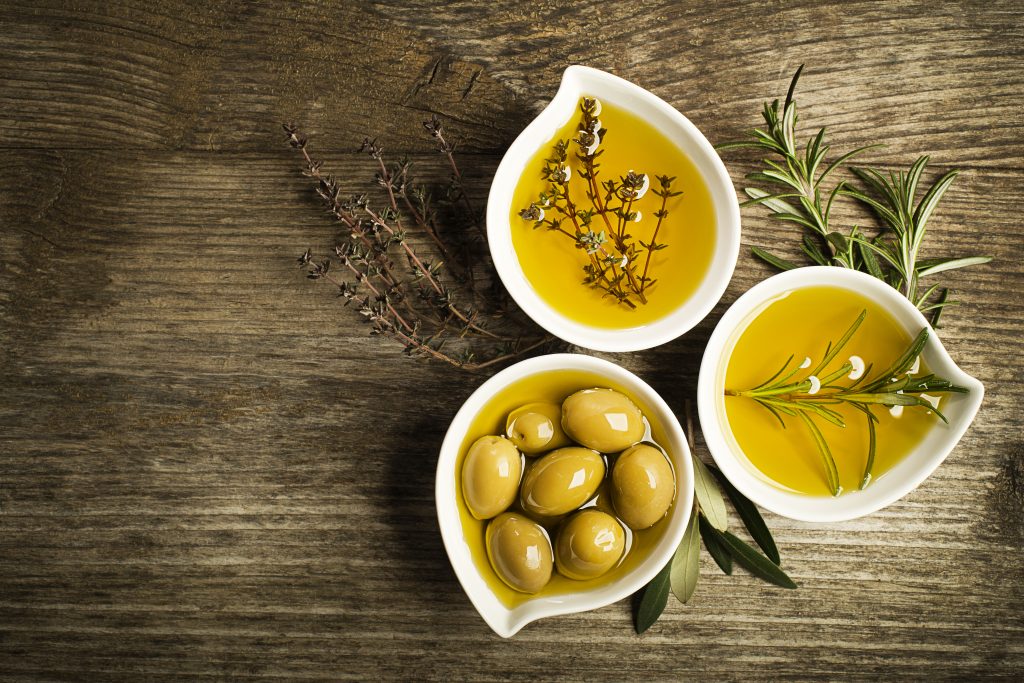Olive oil is an ancient food and liquid that is obtained by pressing fresh olives. It is a pantry staple as many recipes depend on it, most commonly being used as a dressing in salads. Olive oil is praised for its health benefits as it contains a large number of antioxidants and phytonutrients which contribute to it’s anti-inflammatory and cardiovascular health benefits. Some studies show it also contains anti-bacterial properties against harmful bacteria that causes stomach ulcers and stomach cancer. In spite of being a fat, olive oil does not contribute to significant weight gain or obesity, as it has been shown to lower blood sugar levels. This has made it a primary component of the Mediterranean diet. Because of its popularity, many other oils such as sunflower or soybean oil have been fraudulently sold as olive oil.
” If you cook, you probably have a bottle [of olive oil] in your cupboard.
And it is probably fake.”
(page 86, Olmsted, L).
When I first read these words, I didn’t entirely believe them, but who was I to refute them. So I read on and then I ran for the kitchen, took out the bottles and began to taste every one of them. ‘Was there a burn?’- if not the bottle went (Olmsted, L., 2016). Olive oil deceit is so prevalent on a global scale that simply looking for ‘Extra virgin olive oil’, ‘Made in Italy’, a dark glass bottle or ‘Organic’ is no longer an option.
The History of an Oily Fruit
Though wild olives, with approximately 40 distinctive species, grew (and continue to grow) from tropical Africa to the southern rolling hills and plateaus of Central Asia, it was in Palestine – which is part of the fertile crescent – that the olive tree Olea europea was domesticated around 4000 BC for the oil of its fruit (Diamond, J., 1999). Olea europea, the species of olive domesticated, is larger and produces far more oil than its wild cousin Olea oleaster (which is more ‘thorny bush’ than a tree) (Mueller, T., 2011). The oil found in the olive is necessary for seed germination, however far more oil is produced than the seed would need. This has led to the theory that olives produce more oil as a way to make the fruit look more appetizing which aids in its dispersion and subsequent germination after being consumed and seed expectorated (ibid)
Over the next 3000 – 4000 years, the cultivation of olive trees spread across the Fertile Crescent/Mediterranean. Olive oil and subsequently the horticulture of olive groves were introduced to Egypt in 3000 BC and 2000 BC respectively.
Olive oil was highly prized in Egypt as a motif for art, body lotion for sunburns and to smooth dry skin, a fuel for temples and homes as well as a common grave good to send them through to the afterlife. As olive oil production grew and was becoming for several Mediterranean civilizations their “life-blood”, trade began to move into Carthage in Africa and eventually into Italy in around the 7th to 6th century BC (Mueller, T., 2011) (Janick, J., 2005).
In the prominent centers of olive oil production in the ancient world (Palestine, Egypt, Greece, Italy), oil was produced on a remarkably large scale. Archaeologists have come upon several areas across the Mediterranean that display ancient olive oil manufacturing centers. One such dig unveiled 100 enormous presses that utilized logs to squeeze out oil from fruit estimating production of about 500,000 liters of olive oil annually (Mueller, T., 2011) (Davidson, A., 2014).
Initially, olive oil was not used for consumption. In Palestine, for instance, sesame and walnut oil were predominantly used as cooking oils. Olive oil was utilized across the Mediterranean as a body lotion, a perfume carrier and for medicinal purposes, as well as a fabric softener in textile manufacturing, a lubricant for machinery and a fuel source for furnaces, temples, and homes (as it burned for a long time and left a pleasant smell) (Olmsted, L., 2016) (Mueller, T., 2011).
Olive oil’s golden age was with the Greeks, who to this day praise it, consuming on average 23-24 liters of olive oil per person per Annum. In ancient Greece olive oil was utilized for its spiritual and aesthetic properties; it was used as a contraceptive, a detergent, a cure for heart illness, stomach pains, loss of hair, intestinal gas, excessive perspiration, as well as being a preservative and a pesticide (Mueller, T., 2011). Olive oil was the economic essence of Greece, it built up their culture, influencing and aiding in the growth of the theatre and the Olympic Games. As such, the Greek government always ensured that the demand was met with supply (ibid).

In Ancient Rome it was prized for its commercial possibilities. It was a symbol of a higher power, of refinement, it was their identity and a victory for Roman Cuisine over that of Barbarian beer and lard. During that time the average Roman citizen would consume approximately 50 liters of olive oil annually. When Septimius Severus came into power (193-211 AD) he required his home State (Leptis Magna a Roman Province in Africa) to present to him 1,000,000 liters of Olive Oil annually as an offering. This he did to improve his favor among the Romans in Rome distributing it out to them freely. When the oil arrived in Rome it would be emptied and the ceramic jars that held the olive oil would be thrown into Monte Testaccio, which is now a reminder to the importance of olive oil to Ancient Rome. At the height of Olive oil in the Roman Empire (around 2nd century AD) Rome was obtaining approximately 7.5 million liters annually. Every empty ceramic jar went to Monte Testaccio, which is now a grassed over hill holding beneath it roughly 53 million ceramic jars which once held about 6 billion liters of oil (Mueller, T., 2011) (Amusingplanet.com).
In modern times in southern Italy, Puglia is globally famed for olive oil production and produces 40% of Italy’s olive oil. With more than 60 million olive trees growing locally it is easy to come upon real extra virgin olive oil there. However, it is just as likely to come upon a fake.
Fake Olive Oil Production
Olive oil is one of the most faked foods in Europe. Looking at a giant sea of olive trees may take one’s breath away but the business is far less handsome in Italy. There are armed oil bandits who embezzle farmers’ oil into giant tankers. The Mafia has a giant hand in the making of fake olive oil. Some farmers outgrow their small farms and to keep up with demand, to keep their cash cow growing, they begin substituting the real stuff for the fake and selling it to a market that won’t know any better – North America (Mueller, T., 2011).
One such individual is Domenico Ribatti. In the late summer of 1991, an oil tanker pulled out of a Turkish port with 2,200 tons of hazelnut oil. When the same tanker docked in the early autumn at a port in Puglia, Italy its ship’s log documented the same oil as being Greek Extra Virgin Olive Oil. From there it was transported to one of Ribatti’s processing plants, refined (as it was not truly olive oil but hazelnut) and sold to some of the biggest manufacturers of olive oil in Italy; Nestlé, Unilever, Bertolli, and Oleifici Fasanesi, who all went on to sell their product to the global market (Mueller, T., 2011) (Mueller, T., 2007).
Although Ribatti was eventually prosecuted and after spending 13 months in jail left the Olive Oil Business, the companies he sold to still kept the $12 million in EU subsidies that were being handed out in the 90s to entice big businesses to purchase from small farmers. They haven’t purchased olive oil from small farms, nor had they purchased olive oil. Could they have not known? It is rather unlikely and more unlikely still, is that they have changed the way they conduct business after the incident. More extra virgin olive oil is being exported from Italy then is being made there today. No matter how you do the math it is impossible to say that it is all pure extra virgin olive oil, it’s even more impossible than it’s Italian (Mueller, T., 2011) (Mueller, T., 2007).
In Italy, as in many other places on the planet, small businesses are being overshadowed by big businesses that produce high quantity and low-quality goods. Just as it’s good to get to know your egg farmer here in Ontario it’s good to get to know your olive oil maker, do your research, become aware, become informed and in the process you’ll be doing yourself a favor by eating more healthy!
Benefits of Extra Virgin Olive Oil
In the early 1990’s Gary Beauchamp a psychobiologist for the Monell Chemical Senses Centre was hired by the British company Lemsip (makers of cold and flu medicine). They had recently formulated an anti-inflammatory ibuprofen remedy. However, the once delicious hot lemony beverage now left a horrible burning feeling at the back of the throat. Although Beauchamp was able to make some suggestions about how to make the remedy taste better the burning sensation would not go away (Schatzker, M., 2015).
It was not until 1999 when Beauchamp attended a conference in Erice, Italy that he finally came to understand where the burning sensation was coming from. He was given a taste of olive oil from Palermo (two physicists had brought their own to the conference to hold a tasting) and was struck in amazement by the same burning sensation that he had received from ibuprofen (Ibid).
Olive oil consists of an anti-inflammatory, plant secondary and phenolic compound called oleocanthal. It is the singular irritating metabolite in Virgin Olive Oil and the compound that provides the bitterness and the burning sensation at the back of the throat – known as the ‘olive sting’. The more potent the bitterness – which is characteristic of oil that is of the highest quality – the more effective it will be as an anti-inflammatory, antioxidant and antimicrobial (Parkinson, Keast, 2014). (Schatzker, M., 2015)
The oleocanthal in olive oil acts like ibuprofen in the body, affecting the same pathways. They both block cyclooxygenase enzymes in the prostaglandin-biosynthesis pathway which aids in reducing inflammation across the body. A great way to test out the effects of oleocanthal in olive oil (if the oil is pure and unadulterated) is to take a tbsp or two of it when you get a headache. Unlike ibuprofen, it will not have any repercussions on the body, if it truly is pure extra virgin olive oil (Beauchamp, G. K. et al, 2005).

Real extra virgin olive oil (EVOO) exhibits many beneficial actions on the body in respect to enhancing health. Oleocanthal has been shown to have positive effects on the neurodegenerative disease (Alzheimer’s) and reducing inflammation in the brain. Although North America is the highest per volume consumer of olive oil, it does not consume the highest amount per person, nor is the quality of the oil beneficial – thus the health effects on the body are not conveyed as they are in the Mediterranean (Parkinson, L., Russel, K., 2014).
Partially due to the oleocanthal and partially to the other secondary compounds, olive oil has also been shown to be very beneficial as an anticancer agent. By blocking cyclooxygenase enzymes in the prostaglandin-biosynthesis pathway the conversion of arachidonic acid to prostaglandins and thromboxane (which are manufactured in reaction to inflammation and high body toxicity) are blocked aiding in the prevention of cancers of the breast, lung, prostate and gastrointestinal tract (Parkinson, L., Russel, K., 2014).
Olive oil – that is to say, oil squeezed from almost ripe, ‘just picked off the tree’ olives, unprocessed, unrefined and unadulterated – has been honed for medicinal purposes for thousands of years. Whether it has been as a soothing lotion for burnt skin (as it is a high source of Vitamin E and antioxidants it provides skin cells with the nourishment they need to heal), used as a throat gargle (the secondary compounds – oleocanthal being one and numerous other chemical compounds such as various phenols, terpenes, flavones, hydroxycinnamic acids, anthocyanins, flavonols, hydroxybenzoic acids and hydroxyphenyl acetic acids – aid in cleaning and detoxifying the throat of environmental pollutants such as smoke accumulation, which over time changes the physical structure of the cells of the esophagus, it is popular in Greece for smokers to use it in such a way) as well as an oil to nourish hair with (High vitamin E and copper help to keep hair color vibrant into old age as well as keeping roots strong and health) (Mueller, 2011).
If you can get your hands on a good bottle of Extra Virgin Olive Oil (EVOO) it is an amazing food source to add to your everyday diet. Olive oil is between 75% – 80% monounsaturated fat, around 8-10% omega 6 and 1% omega 3 (Erasmus, 1993). Although olive oil may not be the richest source of essential fatty acids, it is one of the highest sources of oleic acid (a monounsaturated fat). Oleic acid is the most prevalent monounsaturated fat in human cells, intertwining itself into the phospholipids of cell membranes and ensuring that the membrane’s fluidity is properly functioning (the receptivity of hormones/hormone balance, nutrient transportation, and immune strength all rely on a fluid membrane) (SpectraCell, 2017).
Extra virgin olive oil (EVOO) is very high in Vitamin E, which is beneficial for bringing healthy levels of cholesterol back into balance and reducing inflammation – which in turn aids in disease prevention and fighting free radical damage. Being an antioxidant it also brings more oxygen into the body, thus aiding in the prevention of cellular oxidation and is beneficial for individuals who are at risk of developing Alzheimer’s disease by not only reducing inflammation in the brain but also providing more nutrients to the brain to improve its function. By strengthening capillary walls, Vitamin E also aids in the repair of damaged cells. Vitamin E is an extremely beneficial nutrient for the body and is one of the reasons why olive oil is so advantageous to one’s health (Erasmus, 1993) (Holford, 2009).
Olive oil also contains many plant secondary compounds, such as squalene which is heart-protective and phytosterols which aid in balancing cholesterol levels in the body. The combination of all these nutrients is what makes olive oil one of the primary beneficial aspects of the Mediterranean diet. However, if the oil is refined in any way or oxidized, the benefits will be lost (Erasmus, 1993).
References
Beauchamp, Gary K. et al. “Phytochemistry: Ibuprofen-Like Activity In Extra-Virgin Olive Oil”. Nature 437.7055 (2005): 45-46.
Davidson, Alan. The Oxford Companion To Food. 1st ed. Oxford [u.a.]: Oxford Univ. Press, 2014.
“Designations And Definitions Of Olive Oils – International Olive Council”. Internationaloliveoil.org. N.p., 2017. Web. 11 Apr. 2017.
Erasmus, Udo. Fats That Heal Fats That Kill. 1st ed. Burnaby, BC: Alive Books, 1993.
Frankel, E.N., Mailer, R. J., Shoemaker C.F., Wang, S.C., & Flynn. J.D. (2010). Tests indicate that imported “Extra Virgin” Olive Oil often fails International and USDA Standards. University of California Davis; California.
Gelpí, Emilio et al. “The Spanish Toxic Oil Syndrome 20 Years After Its Onset: A Multidisciplinary Review Of Scientific Knowledge”. Environmental Health Perspectives 110.5 (2002): 457-464.
Holford, Patrick. The Optimum Nutrition Bible. 1st ed. London: Piatkus, 2009.
Janick, J. (2005). The Origin of Fruit, Fruit Growing, and Fruit Breeding. Plant Breeding Rev. 25:255-320
“Monte Testaccio: The 2,000-Year-Old Garbage Dump In Rome”. Amusingplanet.com. N.p., 2017. Web. 12 Apr. 2017.
Mueller, T. (2007, August). Slippery Business, The Trade in adulterated olive oil. The New Yorker.
Mueller, T. Extra Virginity. 1st ed. New York: Atlantic Books Ltd, 2011.
“Oleic Acid”. SpectraCell Laboratories. N.p., 2017. Web. 11 Apr. 2017.
Olmsted, Larry. (2016). REAL FOOD/FAKE FOOD why you don’t know what you’re eating and what you can do about it. 1st ed. North Carolina: ALGONQUIN OF CHAPEL HILL.
Parkinson, Lisa, and Russell Keast. “Oleocanthal, A Phenolic Derived From Virgin Olive Oil: A Review Of The Beneficial Effects On Inflammatory Disease”. International Journal of Molecular Sciences 15.7 (2014): 12323-12334.
Schatzker, Mark. The Dorito Effect: The Surprising New Truth About Food And Flavor.1st ed. New York, US: Simon & Schuster (us & Uk), 2016.
Further Readings
UC David Olive Oil Centre – Reports – http://olivecenter.ucdavis.edu/research/reports
Real Food/Fake Food by Larry Olmsted
Amanda Filipowicz is a certified nutritional practitioner (CNP) with a bachelor in environmental studies (BES) from York University. She also has certification in clinical detoxification, prenatal and postnatal care as well as nutrition for mental health. She has been working as a nutritionist since 2013 and is a lifelong proponent of eating healthy.

